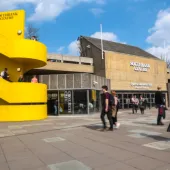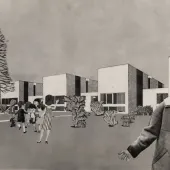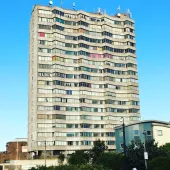UoL celebrates Brutalist architecture with public art audio trail
The University of Leeds (UoL) has launched a new public art audio trail, highlighting its collection of public art set against the backdrop of its Brutalist architecture.
The trail, which requires no booking, offers visitors the chance to explore 21 sculptures, friezes, and installations across the University estate. By scanning QR codes, visitors can access insights from experts, academics, and the artists themselves.
The trail begins with Simon Fujiwara’s ‘A Spire’ on Woodhouse Lane and traverses the entire campus, featuring works by renowned artists such as Henry Moore, Barbara Hepworth, and Eduardo Paolozzi. Notably, it includes modernist landmarks that reflect the University’s rich architectural heritage.
One of the highlights of the trail is Henry Moore’s ‘Three Piece Reclining Figure No.2: Bridge Prop’ (1963), which has been relocated to an outdoor setting in Chancellor’s Court. This area is surrounded by Grade II-listed buildings designed by Chamberlin, Powell & Bon, the architects behind London’s Barbican. These structures are emblematic of the Brutalist movement, characterized by their use of raw concrete and functional geometric designs and include the Roger Stevens Building, a lecture theatre complex, completed in 1970. It features angular lines and exposed concrete, creating a striking visual presence.
Also on the campus is the E.C. Stoner Building, also designed by Chamberlin, Powell and Bon, and also on the UoL’s campus. Completed in the early 1970s, this multi-storey building features stark, raw concrete and a robust, functional aesthetic, reflecting the Brutalist emphasis on practicality and form.
“These buildings were designed at exactly the same time as Moore created his sculpture,” explains Layla Bloom, the University’s curator. “His distinctive bronze is now complemented both visually and historically by Chamberlin, Powell & Bon’s glass and cast concrete architecture.”

Liliane Lijn’s ‘Converse Column’ on Woodhouse Lane, a rotating and illuminated sculpture, is another significant work on the trail. Lijn provides a first-hand account of the ideas that inspired her creation, enhancing the trail’s appeal.
The public art audio trail also delves into personal stories behind the artworks. For instance, the son of sculptor Austin Wright shares memories of his father’s creative process, adding a human element to the exploration of the campus’s art and architecture.
“The architects’ vision reflected a wider postwar enthusiasm for reimagining spaces fit for a progressive new generation,” Bloom adds. This vision aligns with the Brutalist movement’s focus on practicality and social purpose, aiming to open the campus to a more diverse student body and the broader community.
The University of Leeds public art audio trail is open to all, with free maps available from The Stanley & Audrey Burton Gallery and The Treasures of the Brotherton Gallery. A digital version can be downloaded, and each interview is accessible via mobile devices through QR codes at each artwork. The full playlist of interviews and audio descriptions is also available on the University of Leeds Library Galleries Soundcloud.
By integrating public art with its Brutalist architecture, the University of Leeds offers a unique opportunity for visitors to engage with both art and design in a meaningful way.








